The National flag of any country represents the people of that country, their history, language and culture. Bulgaria is a country in the Balkan peninsula, bordering the Black sea to the east. Bulgaria has a long history. Different groups of people like the Thracians, Macedonian, Romans, Celtic and Slavs settled in the land of Bulgaria and contributed to the early development of civilisation there.
In 632 AD the Bulgars, who were Turkic, semi-nomadic warrior tribes, settled in Bulgaria and formed an independent state, known as Great Bulgaria. The Bulgars later merged with the previously settled Byzantine (i.e the Eastern Roman Empire) populations and the Slavs, thus forming the ancestors of Modern Bulgarians.
Description
The current flag of Bulgaria was officially adopted in 1990. It is a tricolour, featuring three equal horizontal bands of White (top), Green (middle) and Red (bottom). It is rectangular in shape. The Bulgarian flag’s ratio (width to length) is 3:5. There are 4 important variants of the Bulgarian flag. They are —
National Flag of Bulgaria
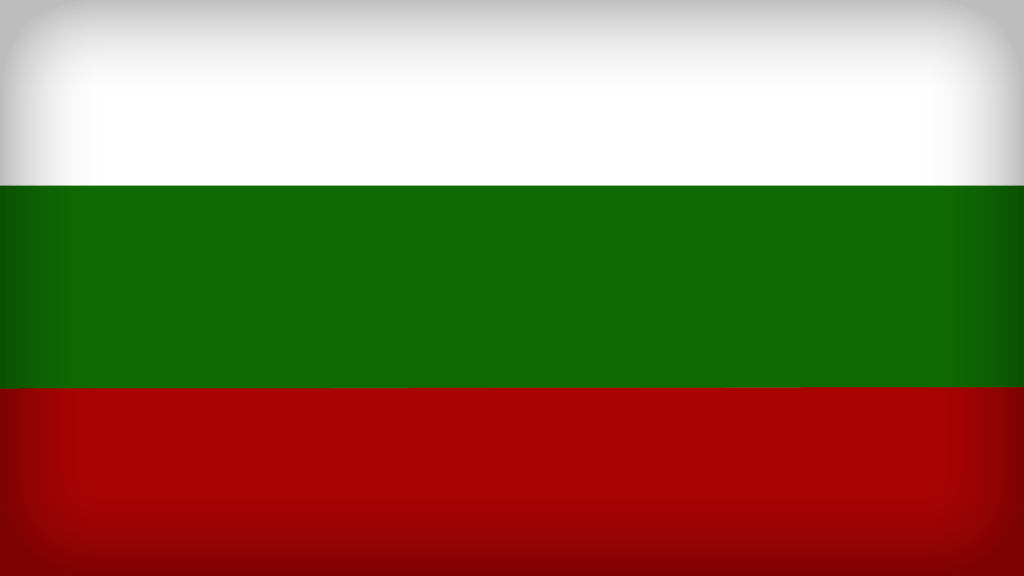
The National flag of Bulgaria is the horizontal tricolour of white, green and red.
Office Flag of Bulgaria
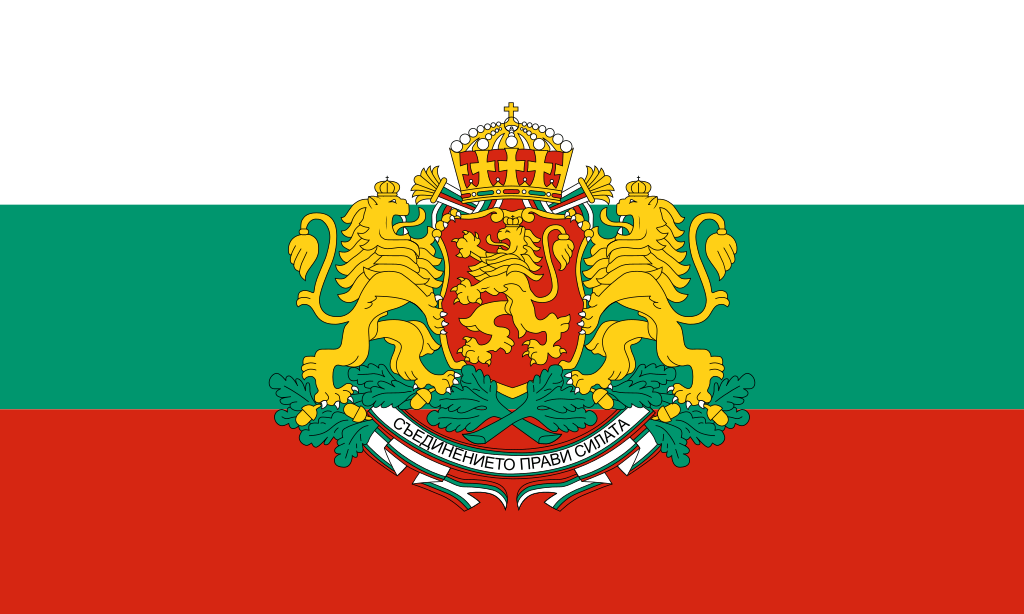
The Office flag of Bulgaria is the horizontal tricolour of white, green and red with the Coat of Arms in the middle. This flag is also commonly used in Bulgaria.
Military flag of Bulgaria
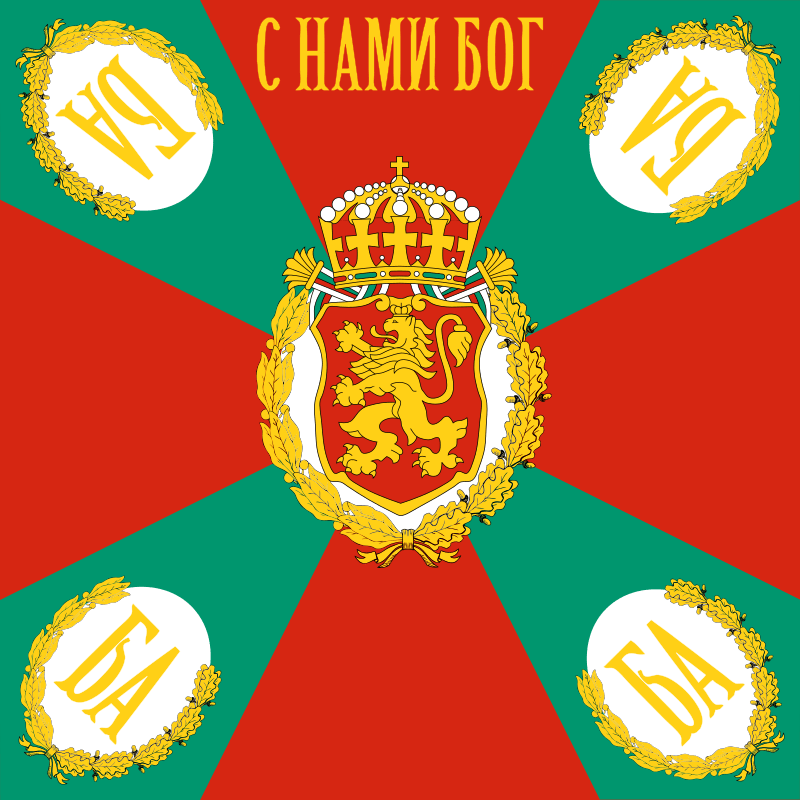
The Military flag of Bulgaria (since 1991) is a green and red flag with the Bulgarian Coat of arms in the middle. The green and red stripes alternately circle the coat of arms.
Naval ensign of Bulgaria
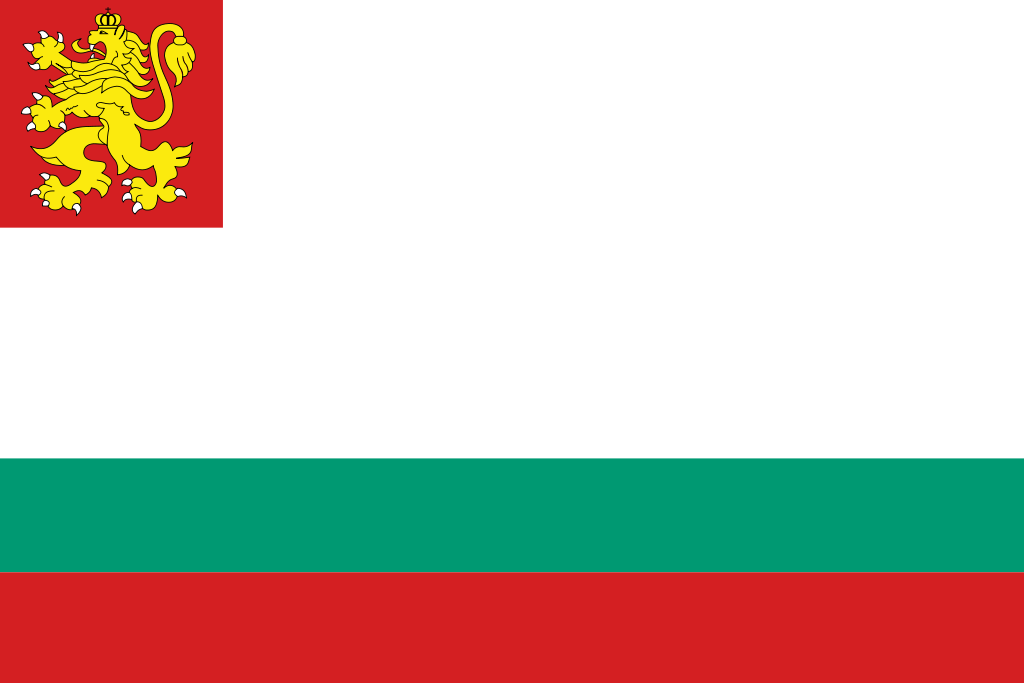
The Naval ensign of Bulgaria (since 2005) is the horizontal tricolour of white-green-red with the addition of the Lion Emblem at the top left corner of the white strip. The lion is on its hind legs with a crown on its head.
Origin and Evolution of the Bulgarian Flag
Depiction on Manuscripts referring to 1st Bulgarian Empire
During the rule of Khan Krum –
The first Bulgarian Empire was founded by Bulgars who settled in the North-Eastern Balkan area. Khan Krum was one of its Greatest Khan (Ruler). Later chronicles depict his army carrying flags in monotone red or red with black borders.
During the time of Tsar Simeon I –
Tsar Simeon I was also part of the Krum Dynasty but Christianised as his father accepted Eastern-orthodox Christianity. Later Chronicles depicts his army carrying red banners. But, these were later chronicles. So the historicity of these flags can’t be verified.
Depiction on Portolan Map
Portolan maps are nautical charts (from 13th C. AD), where we see the depiction of the early Bulgarian flag. The Flag has a white or golden background and depicts either the insignia of the ruling house of Shishman or some unknown symbols in red.
The ruling house of Shishman (1331)
The Shishman dynasty was part of the second Bulgarian Empire. The earliest documented Bulgarian flag was based on Tsar Shishman’s arms. The flag’s design was a white pennant with three red lions.
History of the Color Scheme of the Bulgarian flag
The three colors white, green and red first appeared on the uniforms of the first Bulgarian Legion (i.e a regiment). But the three colors were put in their present order for the first time, on a flag that was designed in the Romanian town of Braila. This is why it is known as the Braila Flag.
The flag was designed by Stiliana Paraskevova, daughter of Ivan Paraskevov. Ivan Paraskevov was a merchant who entrusted his daughter Stiliana with making and embroidering the flag. The flag has a color scheme of white-green-red with an embroidered lion in the middle. The lion is on its hind legs with a crown on its head.
Later on, when the flag was adopted in 1879, the lion was removed from the flag.
Depiction on Tarnovo Constitution (1879)
Bulgaria was under the rule of Ottoman Turks from the late 14th C. AD to the liberation of Bulgaria following the 1878 Russo-Turkish War. Tarnovo Constitution was the first constitution of Bulgaria which came into effect on 16th April 1879. This constitution declared the Bulgarian People’s flag as a tricolour which consists of white, green and red from top to bottom. This is the colour scheme found in the Braila Flag. This remained the National Flag of Bulgaria until 1947. This was the first time the white-green-red horizontal tricolour was adopted as their National flag. This flag was inspired by the Russian flag, the horizontal tricolour of white-blue-red.
Flag of Bulgaria under Communist rule (1947-90)
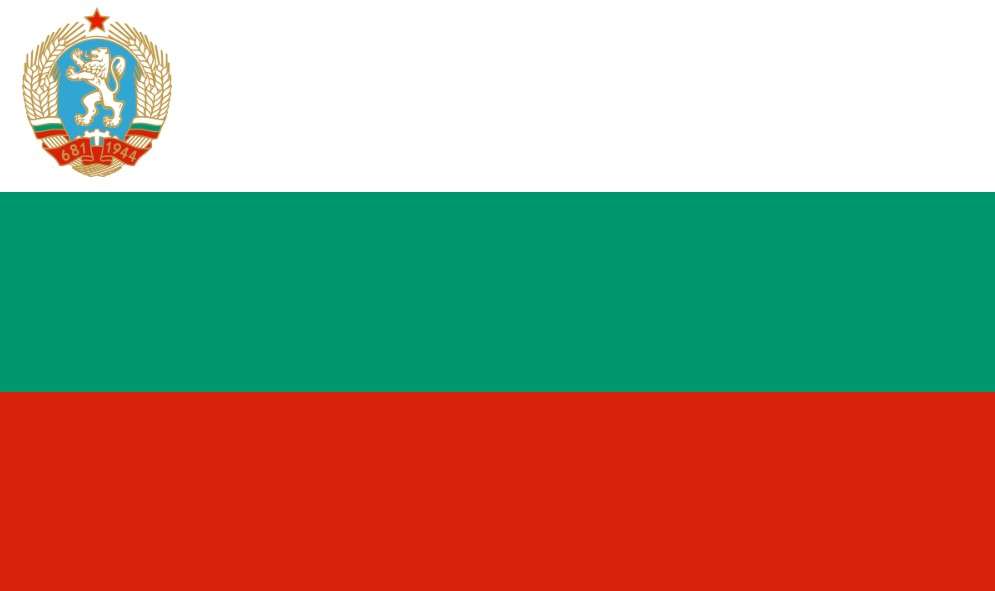
After the Second World War, Bulgaria came under communist rule. The People’s Republic of Bulgaria adopted a new flag. It had a new addition to the previous tri-coloured horizontal bands of white, green and red. The addition is the communist emblem to the left side of the white strip.
The Communist Emblem of Bulgaria was inspired by the State Emblem of Russia. This emblem consists of a red five-pointed star with eight ears of wheat, tied with a red ribbon.
Modern Flag after the fall of communism (1990)
Communist government ended in Bulgaria in 1990 and the new constitution of Bulgaria adopted the pre-communist era flag as the National Flag. In 1998, the Law of the State Seal and National Flag of the Republic of Bulgaria proclaimed that the National Flag signifies the independence and sovereignty of the Bulgarian state.
Meaning and Significance
The Significance of the Colors in the Bulgarian National Flag
The White color of the Flag stands for peace, love and freedom.
The Green signifies the agricultural wealth of Bulgaria.
The Red depicts the independence struggle and military courage of Bulgaria.
The meaning of the Symbol used in the Bulgarian Flag
Bulgarian Coat of Arms

The Bulgarian coat of arms consists of three lions rampant. They are – a crowned golden lion rampant over a red-coloured shield. And other two crowned golden lions rampant support the shield. The Bulgarian historical crown is placed above the shield. Below the shield, is a compartment in the shape of oak twigs and white bands with the national motto “Unity make strength” inscribed on them. The Bulgarian historical crown refers to the crown of Bulgarian Tsars.
The Communist Emblem
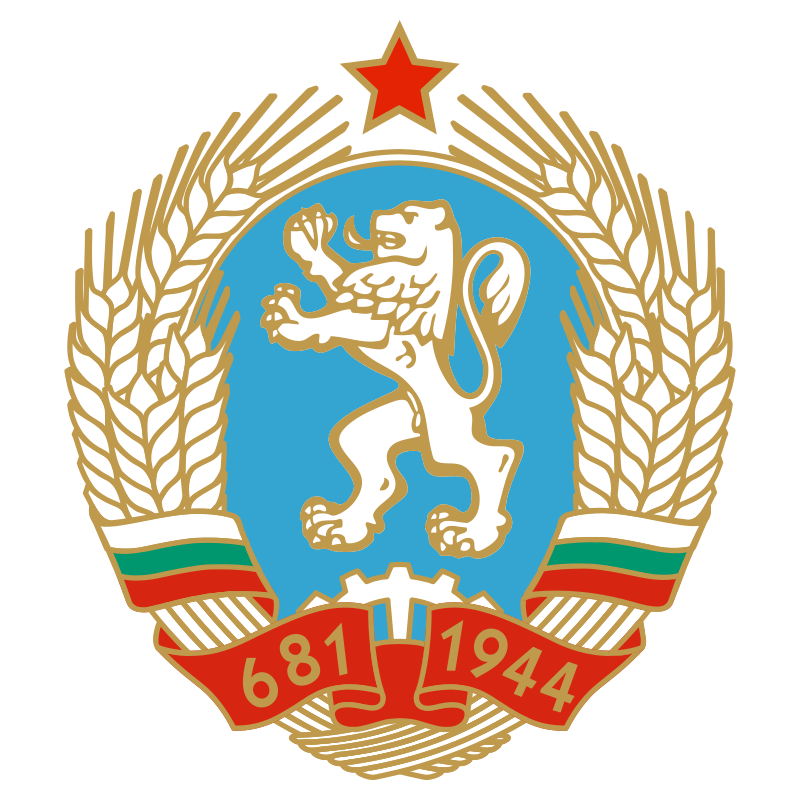
This emblem consists of a red five-pointed star with eight ears of wheat, tied with a red ribbon. This emblem was inspired by the Russian Communist emblem. The red star symbolised the red (communist) army and military service. And the ears of wheat tied with a ribbon symbolises the solidarity of the proletarians.
Heraldic Symbol of Bulgaria (the Lion)
A heraldic symbol means the symbols that are found in armouries. The earliest example of a lion’s image as the heraldic symbol of Bulgaria is found in Lord Marshall’s Roll (composed around 1294 AD).
The Lion’s image is an emblem of Bulgaria’s stateliness. The lion features battle shields, Coats of arms and numerous historical monuments of Bulgaria. Lion symbolises the Supreme divine power, generosity, prudence and justice.
About Bulgaria
Bulgaria is known as one of the oldest states on the European continent. It is famous for its beautiful beaches, antique Churches and monuments. It has over 40,000 cultural monuments, seven of which are listed as UNESCO sites.
Bulgaria is famous for its tourism. It has impressive mountains like Rhodope, Belasitsa, Vitosha, and Slavyanka. And beautiful valleys like Struma and Mesta etc. The Climate of Bulgaria is a mix of temperate and Mediterranean. National parks like the Rila, Pirin and Central Balkan are a paradise for nature lovers. It has one of the highest varieties of vertebrates and the second-highest diversity of avian fauna in Europe. Mammal species like Badgers, Red foxes, European fallow deers, Marbled polecats and bird species like White storks, Common cranes, Dalmatian pelicans, and Griffons are found.
Bulgaria is surrounded by Romania, Serbia, North Macedonia, Greece and Turkey. Some of the important cities of Bulgaria are Sofia, Varna, Plovdiv, Burgas and Ruse. Christianity is the predominant religion of Bulgaria along with minor religions like Islam and others.
Bulgarian culture is a blend of modernity with folk traditions. An essential element of Bulgarian folk tradition is fire, which is used to banish evil spirits and illnesses. Nestinarstvo is a ritual fire dance of Thracian origin. This is included in the list of UNESCO Intangible Cultural Heritage.
Other UNESCO World Heritage sites are Madara Rider, the Thracian tombs of Sveshtari and Kazanlak, the Boyana Church, the Rock-hewn Churches of Ivanovo and the ancient city of Nessebar. The Madara Rider or Madara Horseman is an early medieval large rock relief depicting a horseman on the Madara plateau in Northeastern Bulgaria. Nessebar is an ancient city, rich in historic buildings, often referred to as the ‘Pearl of the Black Sea’.
Bulgarian Folk music is very famous. It uses a wide range of traditional instruments and has a distinguishing feature, which is extended rhythmical time. Their Folk music even won a Grammy in 1990. John Koukouzelis was a Byzantine composer and singer. His influence is great in Bulgaria’s Folk music.
Economically, Bulgaria is an upper-middle-income country. And almost 66.6% of its 3.36 million working people are engaged in the service sector. Some important service sector industries are tourism, information technology and health. Machine building, metal and mineral extraction, production of chemicals, biotechnology and food processing etc are among the major industrial activities. It is also a hub of science and technology and made considerable progress in material science, space exploration and high-performance computing.
By: Pallabi Devi
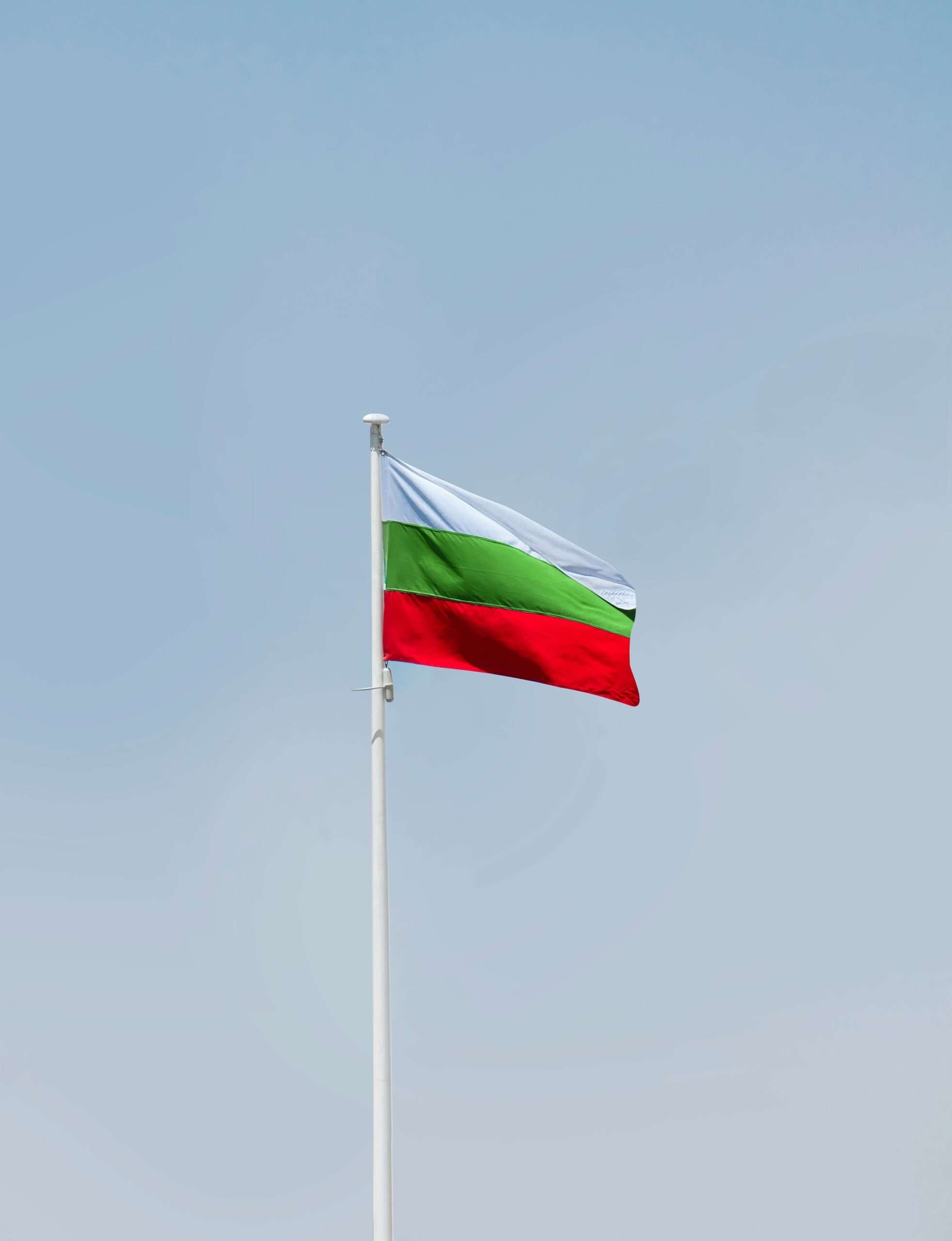
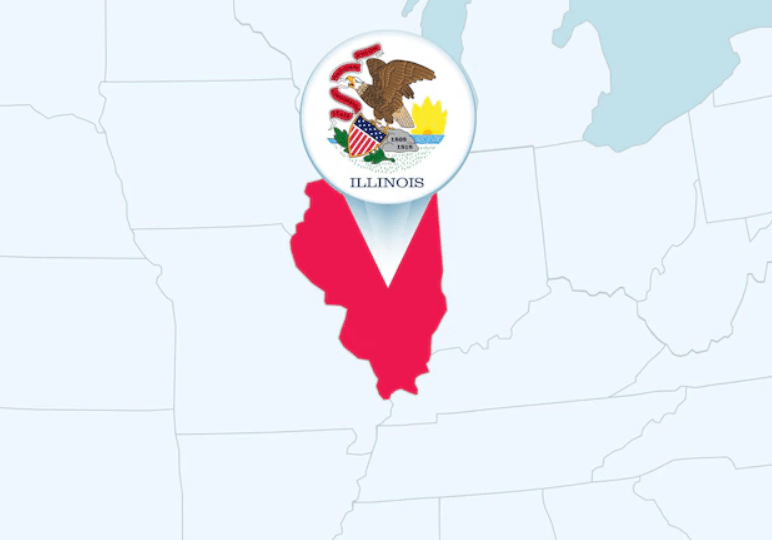


Comments are closed.